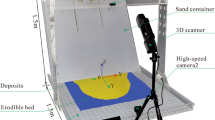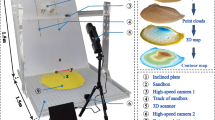Abstract
Laboratory experiments play a key role in establishing rapid sliding models, as they are conducive to providing similar conditions to those in actual mass movement processes and, most importantly, can be conducted repeatedly. In order to elucidate the mass movement mechanisms and assess the landslide intensity as well as the risk of exposed elements following rapid sliding body, laboratory experiments consisting of releasing dry rigid grains or ceramsite debris onto an oblique chute were designed. The intensity and the vulnerability values were evaluated for sand and ceramsite sliding body that impact a single building, a row of buildings, and a group of buildings, respectively. In addition, the sliding characteristics of the mass and the interaction process mechanisms between sliding solid debris and buildings were also able to be obtained. The results show that the velocity of the front-end sliding mass decreases with increasing of the number of buildings. In addition, the vulnerability value of exposed element and the safety distance could be calculated from the recorded data. However, detailed geological factors of the mass, which are also important factors in this experiment, were not taken into account in the model presented in this paper. Nonetheless, this model can be used as a powerful tool for evaluating landslide instability propagation mechanisms.










Similar content being viewed by others
References
Bagnold RA (1954) Experiments on a gravity free dispersion of large solid spheres in a Newtonian fluid under shear. Proc R Soc Lond A225:49–63
Bugnion L, McArdell BW, Bartelt P, Wendeler C (2012) Measurements of hillslope debris flow impact pressure on obstacles. Landslides 9:179–187
Cheng YG (2008) Numerical simulation and monitoring analysis of bedding landslide. Chin J Rock Mech Eng 27:3746–3752
Cruden DM, Varnes DJ (1996) Landslide types and processes. Landslides—investigation and mitigation. In: Keith A, Schuster R (eds) Transportation research board of U.S. National Research Council, Special Report No. 247: 36–75
Denlinger RP, Iverson RM (2001) Flow of variably fluidized granular masses across three-dimensional terrain, 1 Coulomb mixture theory. J Geophys Res 106(B1):537–552
Gassen WV, Cruden DM (1989) Momentum transfer and friction in the debris of rock avalanches. Can Geotech J 26:623–628
Glade T, Crozier MJ (2005) The nature of landslide hazard and impact. In: Glade T, Anderson M, Crozier M (eds) Landslide hazard and risk. Wiley, Chichester, pp 43–74
Heim A (1932) Bergsturz und Menschenleben. Frets und Wasmuth, Zurich
Highland L, Bobrowsky P (2008) The landslide handbook—a guide to understanding landslides. U.S. Department of the Interior, U.S Geological Survey, Circular 1325, Reston, p 129
Hungr O (1995) A model for the runout analysis of rapid flow slides, debris flows, and avalanches. Can Geotech J 32:610–623
Hungr O (1998) Mobility of Landslides in Hong Kong: Pilot Analysis Using a Numerical Model. O. Hungr Geotechnical Research Inc., Canada, A Report for the Geotechnical Engineering Office, Hong Kong, p 52
Iverson RM (1997) The physics of debris flows. Rev Geophys 35:245–296
Jaiswal P, van Westen CJ (2013) Use of quantitative landslide hazard and risk information for local disaster risk reduction along a transportation corridor: a case study from Nilgiri district India. Nat Hazards 65(1):887–913
Jop P, Forterre Y, Pouliquen O (2005) Crucial role of sidewalls in granular surface flows: consequences for the rheology. J Fluid Mech 541:167–192
Jop P, Forterre Y, Pouliquen O (2006) A constitutive law for dense granular flows. Nature 441(7094):727–730
Jop P, Forterre Y, Pouliquen O (2007) Initiation of granular surface flows in a narrow channel. Phys Fluids 19(8):0088102
Ma FS, Wang J, Yuan RM, Zhao HJ, Guo J (2013) Application of analytical hierarchy process and least-squares method for landslide susceptibility assessment along the Zhong–Wu natural gas pipeline, China. Landslides 10:481–492
McDougall S, Hungr O (2004) A model for the analysis of rapid runout landslide motion across three-dimensional terrain. Can Geotech J 41:1084–1097
Ng CWW, Choi CE, Song D, Kwan JHS, Koo RCH, Shiu HYK, Ho KKS (2015) Physical modeling of baffles influence on landslide debris mobility. Landslides 12:1–18
Potter D (1973) Computational physics. Willey, New York
Preuth T, Bartelt P, Korup O and McArdell BW (2010) A random kinetic energy model for rock avalanches: eight case studies. J Geophy Res F Earth Surf 115(3), art. no. F03036
Sassa K, Tsuchiya S, Fukuoka H, Mikos M, Doan L (2015) Landslides: review of achievements in the second 5-year period (2009–2013). Landslides 12:213–223
Savage SB, Hutter K (1989) The motion of a finite mass of granular material down a rough incline. J Fluid Mech 199:177–215
Savage SB, Sayed M (1984) Stresses developed by dry cohesionless granular materials sheared in an annular shear cell. J Fluid Mech 142:391–430
Schuster R, Highland LM (2007) The Third Hans Cloos Lecture. Urban landslides: socioeconomic impacts and overview of mitigative strategies. Bull Eng Geol Environ 66(1):1–27
Teufelsbauer H, Wang Y, Pudasaini SP, Ronaldo IB, Wu W (2011) DEM simulation of impact force exerted by granular flow on rigid structures. Acta Geotech 6:119–133
Van Westen CJ (2013) Remote sensing and GIS for Natural hazards assessment and disaster risk management. In: John Schroder F, Bishop MP (eds) Treatise on Geomorphology. Academic Press, Elsevier, San Diego, pp 259–298
Wang Y, Hutter K (2001) Granular material theories revised. In: Balmforth NJ, Provenzale A (eds) Geomorphological fluid mechanics. Springer, Berlin, pp 79–107
Wang HB, Wu SR, Shi JS, Li B (2013) Qualitative hazard and risk assessment of landslides: a practical framework for a case study in China. Nat Hazards 69:1281–1294
Zhou GD, Charles W, Sun QC (2014) A new theoretical method for analyzing confined dry granular flows. Landslides 11:369–384
Acknowledgements
Financial support from the Fundamental Research Funds of the general project of Chongqing Foundation (cstc2014-jcyjA30016), the Open Research Fund of the State Key Laboratory of Simulation and Regulation of Water Cycles in River Basins (No. IWHR-SKL-201416), the fundamental research funds for the Central Universities (No. 106112014CDJZR200010), and the Natural Science Fund of China (No. 51409026) is greatly appreciated.
Author information
Authors and Affiliations
Corresponding author
Rights and permissions
About this article
Cite this article
Yang, H., Cheng, J. Experimental investigation on the interaction between the rapid sliding body and exposed element. Environ Earth Sci 76, 258 (2017). https://doi.org/10.1007/s12665-017-6565-1
Received:
Accepted:
Published:
DOI: https://doi.org/10.1007/s12665-017-6565-1




